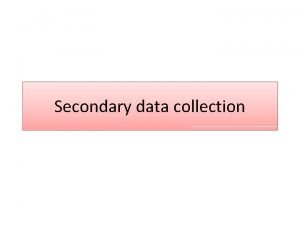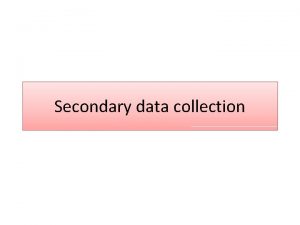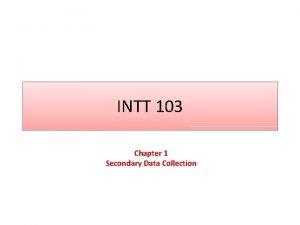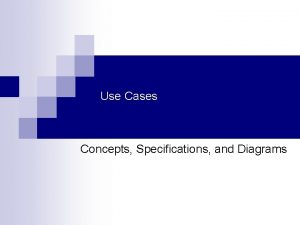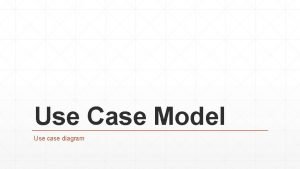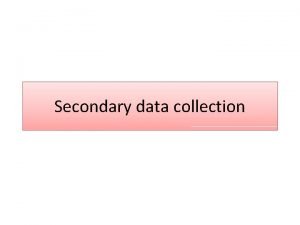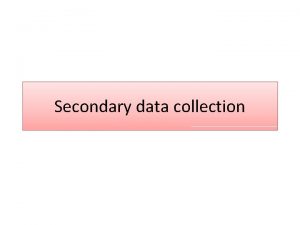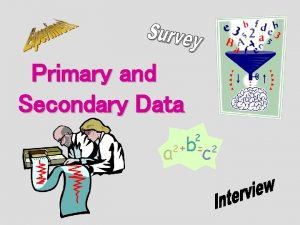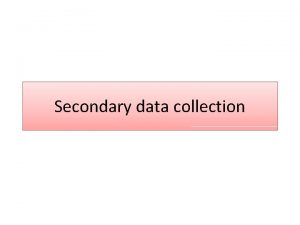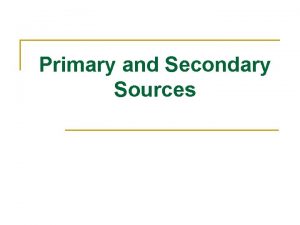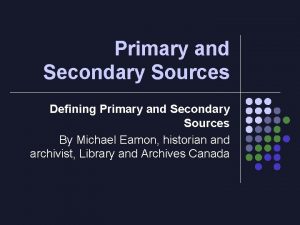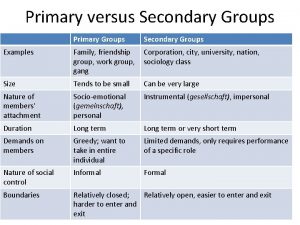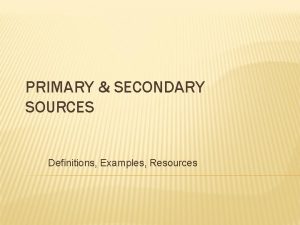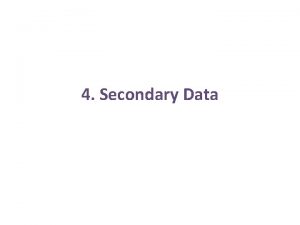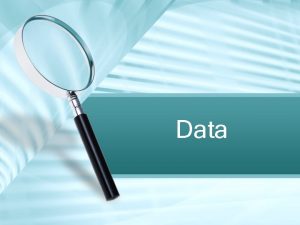Secondary Data Levels of Information n Primary data

















- Slides: 17

Secondary Data

Levels of Information n Primary data are originated by a researcher for the specific purpose of addressing the problem at hand. The collection of primary data involves all six steps of the research process. Secondary data are data which have already been collected for purposes other than the problem at hand. These data can be located quickly and inexpensively. Tertiary data are the interpretation of a secondary source but generally are represented by indexes, bibliography and other finding aids

A Comparison of Primary & Secondary Data Collection purpose process cost time Primary Data Secondary Data For the problem at hand Very involved High Long For other problems Rapid & easy Relatively low Short

Steps to Collect Secondary Data 1. 2. 3. 4. 5. Define your management dilemma or research question Refer textbooks, handbooks, etc. to identify key terms, people or events relevant to management questions Apply key terms, people or events in searching indexes, bibliographies and the web to identify specific secondary sources Locate and review specific secondary sources for relevance Evaluate the value of each source and its content

Uses of Secondary Data n n n Identify the problem Better define the problem Develop an approach to the problem Formulate an appropriate research design (for example, by identifying the key variables) Answer certain research questions and test some hypotheses Interpret primary data more insightfully

Advantages of Secondary Data n n n n Ease accessibility More economical Provide some information, which are difficult to collect from primary sources Less time consuming while data collection Provides valuable insights with respect to subject Base to evaluate or compare primary data Helps in problem identification, formulation of hypothesis and planning data collection

Limitations / Disadvantages of Secondary Data n n n n Obsolete / Time: May be outdated or too old to suit the current situation Purpose: Purpose might be different or biased, which depends upon data collector, its purpose and content Methodology: Sample or methodology may be different. Sample may be unrepresentative. Methodology may not be suitable to our objective Units of data aggregation and classification may be different or not available, for e. g. , data based on age, education, gender, income, area, religion, etc. Sufficiency: Data May not Be sufficient to meet all the requirements for the problem being researched Accuracy: the source of secondary data may not be authentic or reliable Availability: secondary data for the problem on hand may not be available

Criteria for evaluating Secondary Data n n n Purpose – purpose of the source is what the author is trying to accomplish Scope –time period when the data were collected and criteria for selection of specific source Authority – credentials of the author or institution or organization sponsoring the site Audience – whom the information are targeted Format – how information is presented and how easy it is to find a specific piece of information

Criteria for evaluating Secondary Data Evaluating Factor Questions to Answer Purpose Why does the site exist How evident is the purpose Does it achieve its purpose Authority Credentials of the author/institution/organization Does it provide link for further information Who links to the site Sources of facts Scope Time period of information provided How much information is available Criteria for selection of the site Presentation of information Value addition through information Audience Who are the target audience for the site Level of knowledge or experience is required for audience Format Presentation of information Ease of using the site Design of site Guidance for using the site Downloading of information

A Classification of Secondary Data Internal Ready to Use Requires Further Processing External Published Materials Computerized Databases Syndicated Services

Types of Information Sources n n n Indexes and Bibliographies - help to identify and locate a single book or journal article from among the millions published, may be specific to particular topics, useful in a literature search Dictionaries – specialized dictionaries that define words, terms or jargon unique to a discipline. Encyclopedias – useful to find background or historical information on a topic or to find names or terms that can enhance search results in other sources

Types of Information Sources n n Handbooks – a collection of facts unique to a topic, includes statistics, directory information, a glossary of terms and other data such as laws and regulations essential to a field Directories – used for finding names and addresses as well as other data, availability of digital library that can be downloaded

Searching a Bibliographic Database 1. 2. 3. 4. 5. Select the database appropriate to the topic Construct a search query – review and evaluate search results Save results of search Retrieve articles not available in the database Supplement results with information from web sources

Searching Information on World Wide Web 1. 2. 3. 4. 5. Select a search engine or directory Determine search options Construct a search query – review and evaluate search results Save those valuable results of search Supplement search results with information from non-web sources

Internal Secondary Data n n n It provides the in-house information, which provides readily available information and useful insights. Easily available, inexpensive. Database Marketing: Involves the use of computers to capture and track customer profiles and purchase details.

Mining Internal Sources n n n Data Warehouse Data Mining Data Mart

Data Mining Process n n n Sample: decide between census and sample data Explore: identify relationships within the data Modify: Modify or transform data Model: Develop a model that explains the data relationships Assess: Test the model’s accuracy
 Health care levels primary secondary tertiary
Health care levels primary secondary tertiary Research questions
Research questions Primary data
Primary data Primary data in statistics
Primary data in statistics Syndicated sources of secondary data
Syndicated sources of secondary data Primary data and secondary data
Primary data and secondary data Primary data and secondary data
Primary data and secondary data A level 3 question
A level 3 question Primary and secondary effects of a tectonic hazard
Primary and secondary effects of a tectonic hazard Primary secondary stakeholders
Primary secondary stakeholders Primary pollutants and secondary pollutants
Primary pollutants and secondary pollutants Pinotubo
Pinotubo Wastewater treatment process primary secondary tertiary
Wastewater treatment process primary secondary tertiary Use case primary and secondary actors
Use case primary and secondary actors Use case primary and secondary actors
Use case primary and secondary actors Why transformer is a static device
Why transformer is a static device Primary storage and secondary storage
Primary storage and secondary storage Interfascicular cambium is primary or secondary
Interfascicular cambium is primary or secondary



